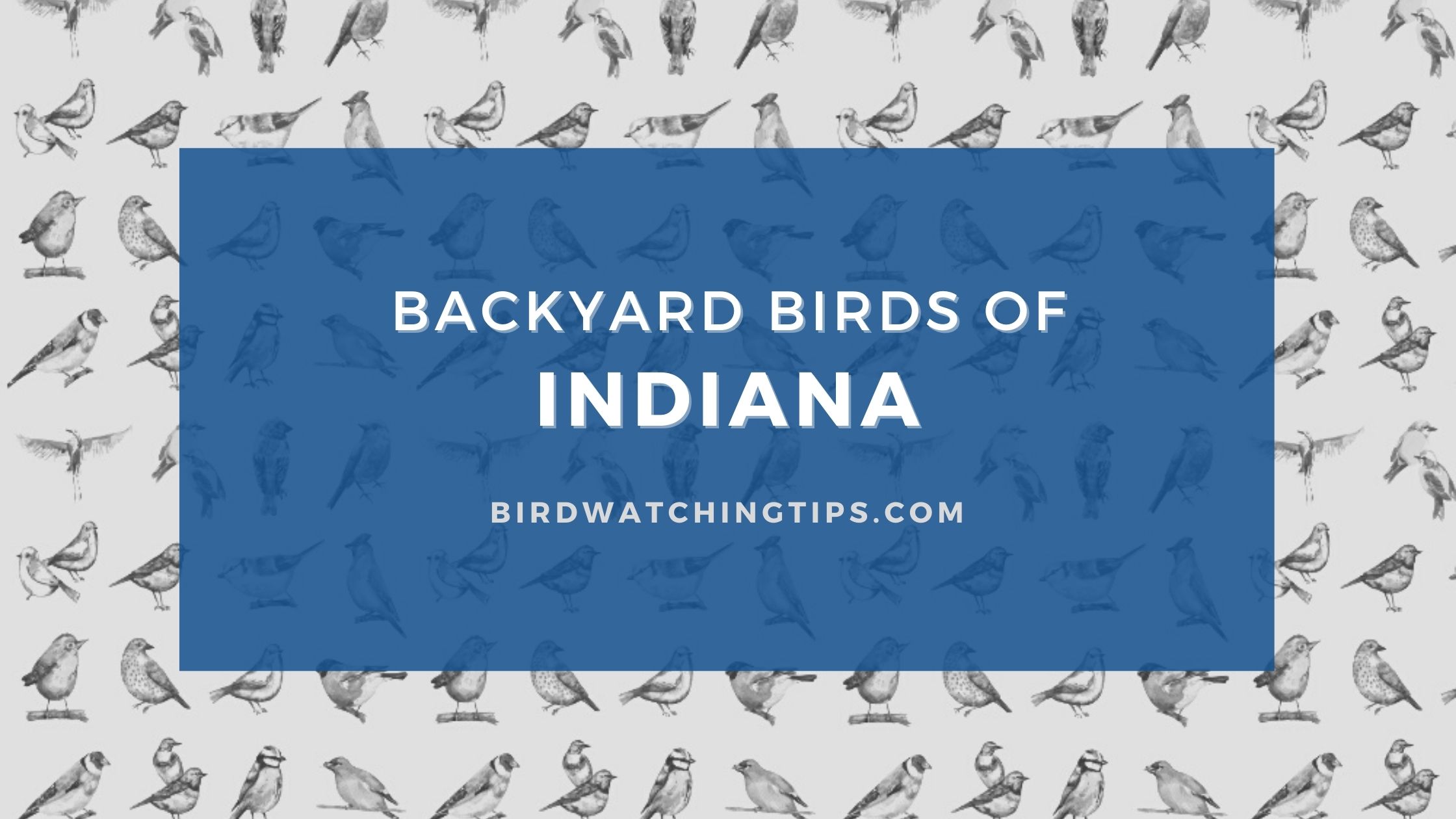Hoosier birdwatchers, today we will be discussing local birds as well as where and when to see them. As you know, Indiana is a great spot for birdwatching and we’ve tried to pack in an assortment that may include a bird or three you haven’t checked off your list yet. Without further ado, let’s talk about the Popular backyard birds of Indiana!
3 Categories – 413 Birds
It’s a formidable checklist, 413 birds, and while we’d love to talk about them all for ease of using this information we’ve broken down examples of 5 birds to watch for and divided them into the seasons to best watch for them. We’ve categorized as follows:
- Year-round Resident birds
- Birds of Spring, Summer, and Early Fall
- Fall and Winter Birds
We’ll give you the information that you need to identify them and lure them but we can make no guarantees. These birds have their own agendas but with a little knowledge and a little luck you might just get some fine feathered visitors.
Indiana’s Year-Round Resident Birds
These birds are in Indiana for ‘the long haul’, going about their business throughout the year during all seasons and this greatly increases your odds of a sighting. Here are some ‘year-round residents’ that you can watch for:
- American Robin
- Red-bellied Woodpecker
- White-breasted Nuthatch
- House Sparrow
- Mourning Dove
American Robin – Turdus migratorius
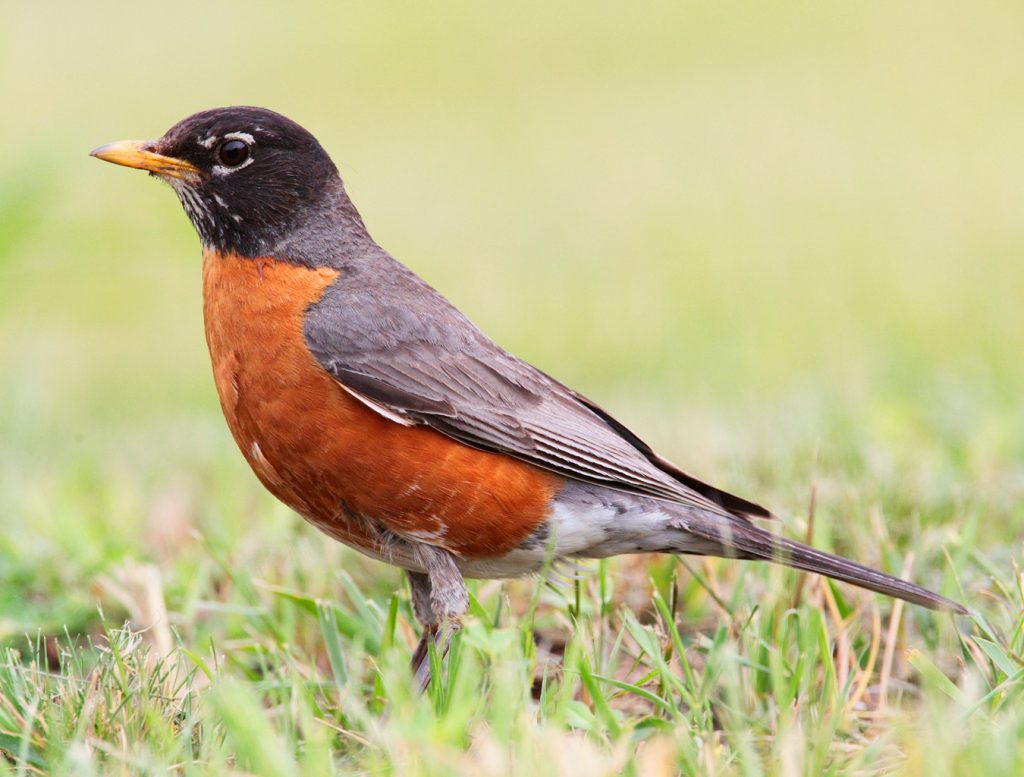
Coloration and Markings: The American Robin is a colorful resident you can see in Indiana. This bird has gray and brown wings and a distinctive orange belly, with a white patch just under the tail which you can spot easily if you’re looking for it and especially when the bird is in flight. Facially, this bird has graying-black head with the females being slightly lighter colored and you’ll notice a small, white ring around the eye. These birds have short, curved yellow bills.
Size: These birds measure in at 7.9 – 11 inches in length and have wingspans of approximately 12.2 to 15.8 inches.
Habitat:. Deciduous trees, parks, fields, or even hopping around in the snow in your backyard. These birds are very social and not afraid of the suburbs.
Diet: American Robins enjoy a number of foods, such as peanut bits, raisins, chopped apples, suet, and sunflower seeds. They are delightful and easy to please, though you show that their favorite is mealworms!
Red-bellied Woodpecker – Melanerpes carolinus

Coloration and Markings: The Red-bellied woodpecker is an attention-getter, with its exotically patterned black and white striped wings. It also has a small, stout tail of the same coloration which helps to hold it stiffly against trees whilst this bird goes about its pecking-business. This Woodpecker has a white underbelly with soft splashes of faint red and facially a white face (sometimes with the same light splotching) and a bold red cap extending down the back of the neck. This bird has a long, straight black bill.
Size: This is a good-sized woodpecker, measuring an around 9.4 inches in length with a wingspan of 13 to 16.5 inches.
Habitat: These birds love Oak and Hickory trees but you’ll find them in all kinds of forests quite commonly. They also like backyards too so be sure to leave them out something yummy.
Diet: These birds like peanuts, sunflower seeds, and suet. Don’t be surprised if you catch one raiding a Hummingbird feeder, either, as some of these Woodpeckers have a sweet tooth.
White-breasted Nuthatch – Sitta carolinensis

Coloration and Markings: These birds have blue and gray wings and tails with black accenting and a white breast and underbelly. Often the underbelly will display a distinctive brown marking and the underside of the tail is white. Facially, these birds display a white face and neck with some white displaying on the underside of the bill, which is black at the top and connects to a gray or black cap that extends back to the wings. The bill is long and straight and it has a thin black line extending from the back of the eye and lightening in color as it approaches the cap.
Size: Roughly Sparrow sized, these birds measure in at 5.1 – 5.5 inches with wingspans of approximately 7.9 to 10.6 inches.
Habitat:. Woodland and woodland-edge regulars, they are particularly fond of Oak trees and their delicious acorns.
Diet: Suet, sunflower seeds, and peanuts will help to lure the White-breasted Nuthatch in for a visit and if you are lucky they might just become repeat visitors!
House Sparrow – Passer domesticus

Coloration and Markings: House Sparrows, like many birds, have some color variation by gender. Both male and female House Sparrows have brown and black striping on their wings but males have brighter coloration altogether. Their breast and underbelly are gray and white with a distinctive black bib, which extends facially up until the lower bill, sharply contrasted by white cheeks. Aside from the checks, most of their heads are a rich brown with a wide amount gray on top. It’s a beautiful contrast. The females are mostly brown with their breast and underbelly being a mix of gray and brown. These birds have perky tails and stout, slightly curved black beaks.
Size: These birds masure in at 5.9 – 6.7 inches and have wingspans of 7.5 to 9.8 inches.
Habitat: As the name implies, these birds are commonly found around buildings and will happily visit your garden or feeder for delicious snacks.
Diet: These birds love all kinds of seeds. Just adding sunflower seeds and corn will do the trick although these birds will likely visit even if you don’t have a feeder. They are very comfortable with our habitats, making these pretty little birds easy to spot once you’re looking.
Mourning Dove – Zenaida macroura
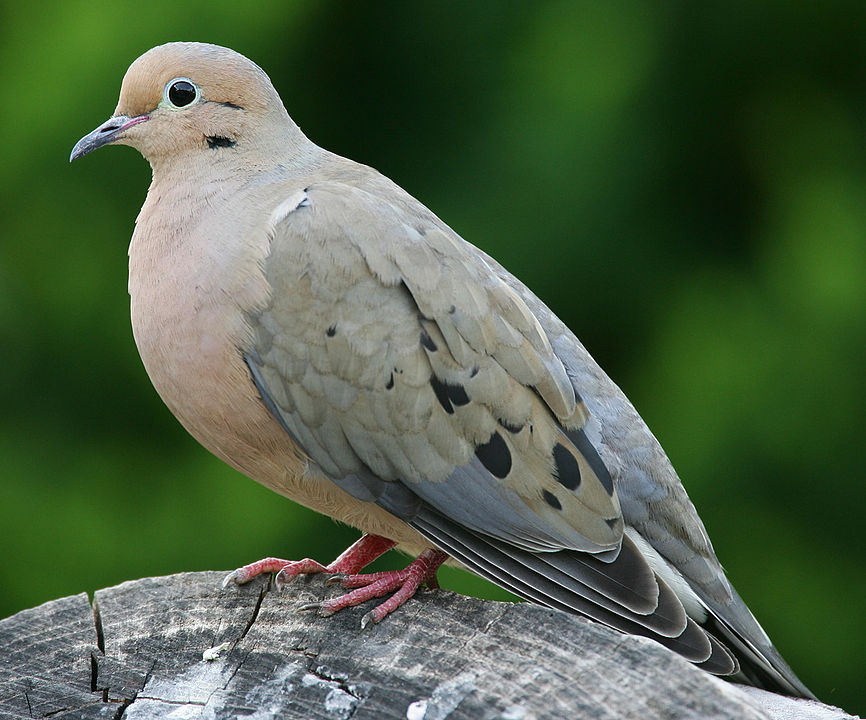
Coloration and Markings: Mourning Doves are typically a tan over very light brown (sometimes with a mix of grey) on their whole bodies. It’s a delicate mix as you can see and some notable features include that the wings tend to be darker than the breast, underbelly, and head and this Dove also has spots on the wing and white tips on its slender tail. They have small and delicate black bills.
Size: The Mourning Dove measures in at 9.1 – 13.4 inches from head to tail and has a wingspan of approximately 17.7 inches.
Habitat: These birds like to nest in places like Evergreen trees or dense shrubberies but you will most often see them hopping around on the ground when you spot your first one or on a telephone pole scoping the area before foraging.
Diet: Scatter some seeds around your feeder for best results. Millet is good and so are sunflower seeds and you can also get their attention with feeding hangers if you don’t like the ground method.
Indiana’s Birds of Spring, Summer, and Early Fall
These birds love Indiana but have strong reservations about its winters. Thankfully, while the winters are cold, they are also short in Indiana, so here are some birds you can spot at any time it’s NOT freezing cold and windy. The Indiana birds of spring, summer, and early fall are as follows:
- American Tree Sparrow
- Purple Finch
- Snow Bunting
- Cedar Waxwing
- Northern Flicker
American Tree Sparrow – Spizella arborea

Coloration and Markings: This handsome little guy is that American Tree Sparrow. Characteristics you will notice are gray wings with thick, brown streaking and some white highlights the shoulder. Typically the breast is going to be a light gray or brown, often with a dark splotch, and with the underbelly tending to be slightly lighter in color. These birds have long tails and very interesting coloration of the face, with gray heads, rust-colored caps, and a rust ‘mask’ outlining the eye and at a curve until almost the end of the neck. They have small stout beaks that are half-yellow and half gray or black.
Size: These birds are small with an average length of 5.5 inches and wingspans of around 9.4 inches.
Habitat: These birds are fond of forest edges, shrubs, fields, and are sometimes attracted to water. They also love visiting feeders but they like to travel in small flocks so be prepared!
Diet: Mealworms, millet seeds and dried berries are the way to these bird’s hearts, so stock up and see who visits!
Purple Finch – Haemorhous purpureus
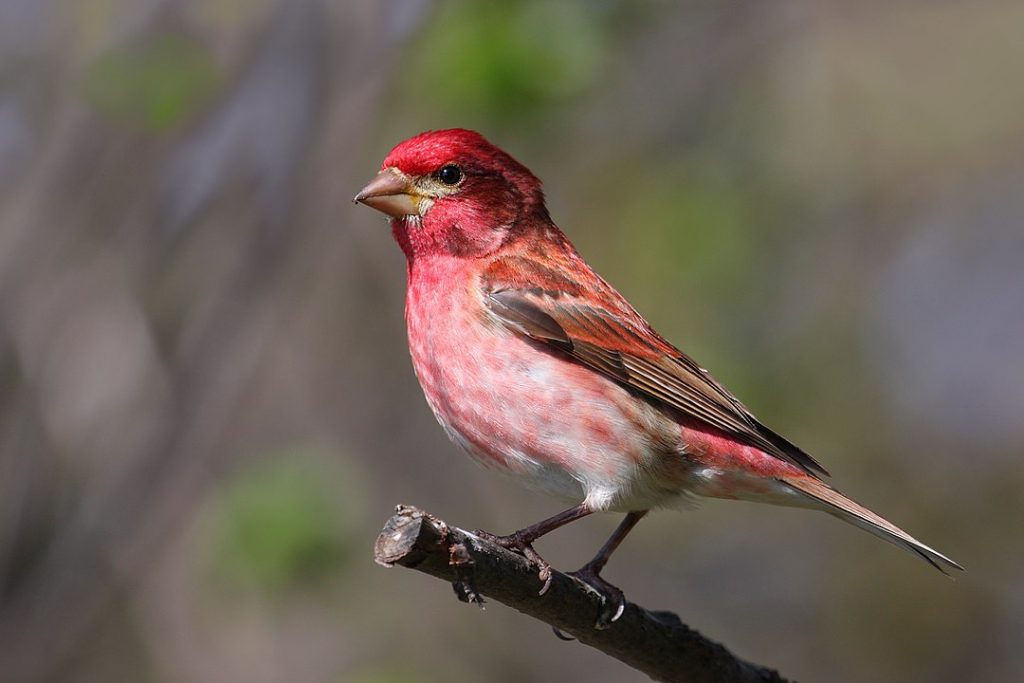
Coloration and Markings: Every now again you get a visit from a real looker and the Purple Finch certainly delivers. The males have wings which are a mixture of dark brown and raspberry, with their white breasts a lighter raspberry-streaked. Facially, raspberry-red faces with a lighter-colored eyestripe and a dark line visible on their throats. Their beaks are strong and yellow, sometimes with a little black highlighting as well. Females don’t get the red coloration but have the same markings, just in a light brown to tan color.
Size: This bird measures in at 4.7 – 6.3 inches and has a wingspan of 8.7 to 10.2 inches.
Habitat: Fond of coniferous forests, these birds also like shrubs, fields, and are not averse to visiting backyards.
Diet: If you have a garden that includes berry vines then this is one way to lure a Purple Finch. If you don’t, these birds are also greedy for Black Oil Sunflower seeds and more than happy to munch in your feeder if you leave some out for them.
Snow Bunting – Plectrophenax nivalis

Coloration and Markings: These striking birds are very easy to identify though you will see variations based on their gender and if they are breeding. The males, for instance, are completely white with the exception of their backs, which will be black. Females, by contrast, will have brown streaking visible on their back with remainder of the body the same white as the male. Outside of breeding season, the females will display rusty-red on the face and breast while the males will display rusty patches on the breast, a distinctive res ‘ear spot’, and a rust crown.
Size: The Snow Bunting measures approximately 5.9 Inches from tip to tail and has a wingspan of 11.8 inches.
Habitat: These birds love fields and are also attracted to water. They tend to nest in rocky areas, recognizing their safety.
Diet: Mealworms are good but these birds also like Nyjer seed and Thistle.
Cedar Waxwing – Bombycilla cedrorum
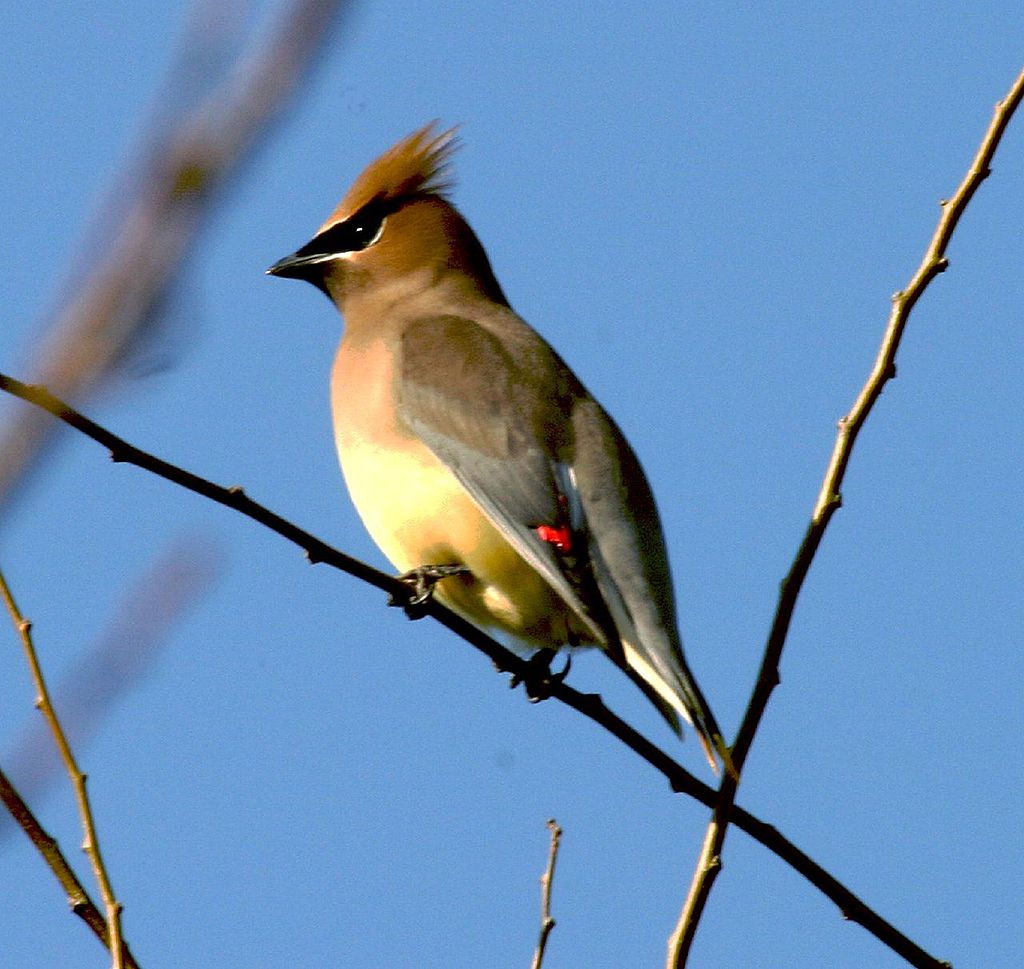
Coloration and Markings: It’s a real treat to spot on of these birds. The Cedar Waxwing has very distinctive markings, which include gray wings with small red tips and they have yellow-tipped gray tails. The underbelly has a faint but noticeable mix of yellow while the breast and face are a rich brown. The face is quite handsome, as the brown coloration is almost like a lion’s mane, with the effect completed by a beautiful mask perfectly outlined in white. Their beaks are small, black, and stout.
Size: Cedar Waxwings are typically 5.5 – 6.7 inches in length and they have wingspans of 8.7 to 11.8 inches.
Habitat: These birds love Evergreen trees and are also attracted to water as well. They are especially fond of fruit-filled gardens so if you’ve cultivated one then you might get to see one of these lovely birds.
Diet: Fruits are the way to lure a Waxwing to your feeder but you need to make the bird feel safe. They are very shy, so try leaving out a mixture of chopped apples, grapes, and raisins if there is one nearby that you’ve spotted and are hoping to host as a guest.
Northern Flicker – Colaptes auratus
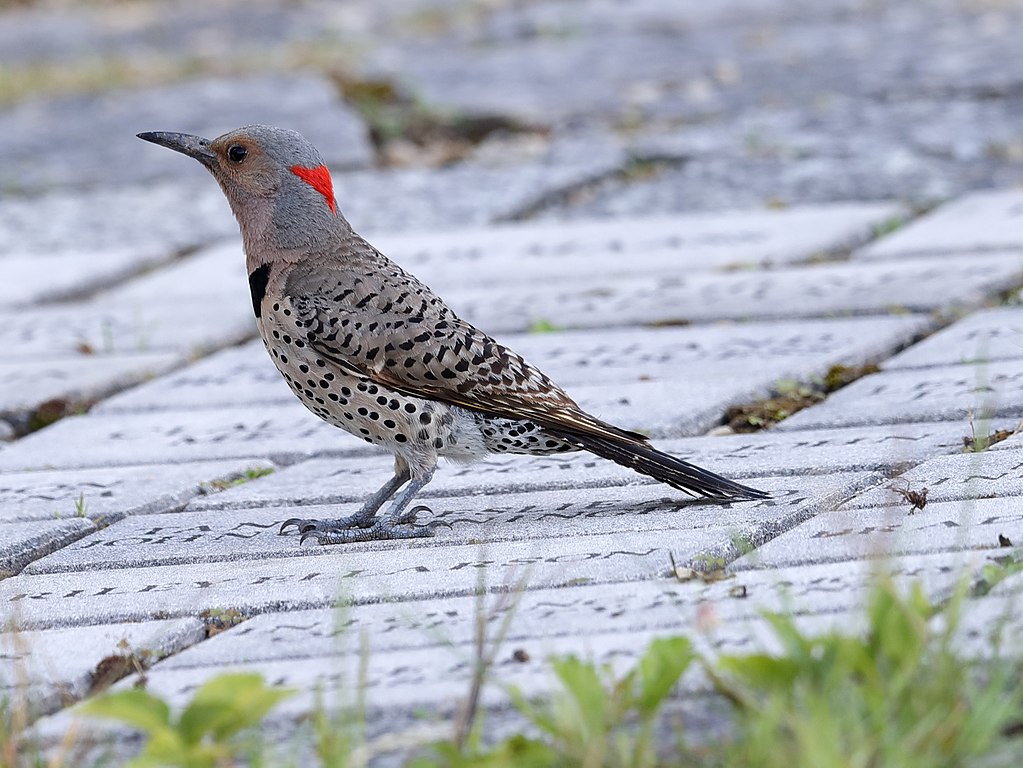
Coloration and Markings: This colorful member of the Woodpecker family has some memorable markings indeed. They have gray wings which are mixed with black spotting and white breasts which are also spotted black as well, with a thick black ‘necklace stripe’. You’ll also notice yellow at the tail tips, which is distancing to the Eastern variety of this bird (with the Western sporting a red tail-tip). Facially, they have blue and gray crowns with tan faces and you will notice a red spot at the back of the neck. Males even have a ‘mustache’ mark extending back from their long, thin bills.
Size: A good sized bird, from tip to tail the Northern Flicker is 11 – 12.2 inches in length with a wingspan of 16.5 to 20 inches.
Habitat: These birds are often found in parks, backyards, or the forest’s edge. You should look down instead of up, however, as they like to forage for insects on the ground.
Diet: Get yourself a Suet feeder that sports an extended tail tip and you might just lure a Northern Flicker to your feeder.
Indiana’s Fall and Winter Birds
Some birds don’t mind those short winters at all and they are out there waiting for the watcher who knows where to look and how to lure. Here are Indiana’s Fall and Winter birds:
- Indigo Bunting
- Chipping Sparrow
- Eastern Wood-Pewee
- Eastern Kingbird
- Brown Thrasher
Indigo Bunting – Passerina cyanea

Coloration and Markings: Also known unofficially as ‘blue canaries’, these colorful wonders are a brilliant indigo blue all over their bodies and sometimes with some minor gray highlights in their wings. Facially, the color deepens and this bird has a silver bill Well, at least for the males. The females, by contrast, look quite different. They are brown, with some white to their throats and some streaking seen at the breast. These are definitely a delight to spot that you will remember.
Size: These are small birds, measuring in at 4.7 – 5.1 inches in length with wingspans of 7.5 to 8.7 inches.
Habitat: Look for them at the forest’s edge, especially where the shrubbery gets deep where you might catch a glimpse of them foraging in the wild.
Diet: Mealworms, Nyjer seeds, and Thistle are a great way to attract these little guys to your feeder.
Chipping Sparrow – Spizella passerine
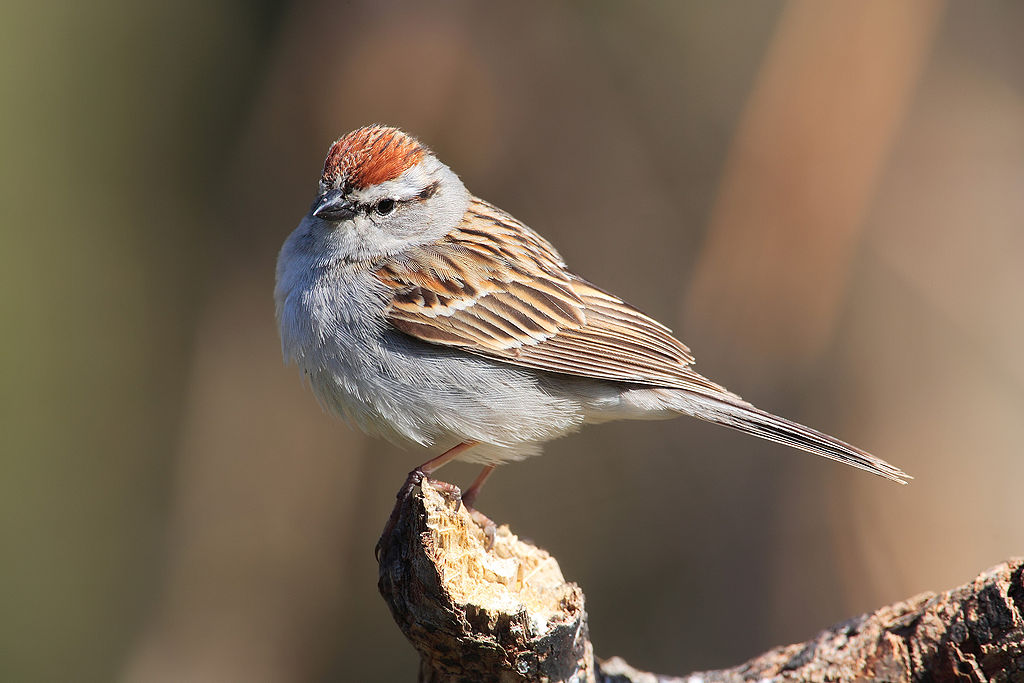
Coloration and Markings: In the winter the Chipping Sparrow has wings with brown and tan streaking. Their breast and belly, by contrast, is a mix of white and gray and they have medium-sized gray tails. Facially, this bird has a white face with a gray patch underneath the eye and a black streak which starts just behind it and goes to the back of the neck. A rusty-cap is on top of it’s head and it has a small and straight black bill.
Size: These birds measure in at 4.7 – 5.9 inches in size with an average wingspan of just 8.3 inches.
Habitat: Found in forests, fields, and parks, these birds are happy to visit your feeder as longas you’ve stocked what they like.
Diet: This bird is very partial to insects but will also eat seeds. Loading your feeder with Nyjer seed, Black Oil sunflower, millet, and mealworms can get this bird’s attention.
Eastern Wood-Pewee – Contopus virens
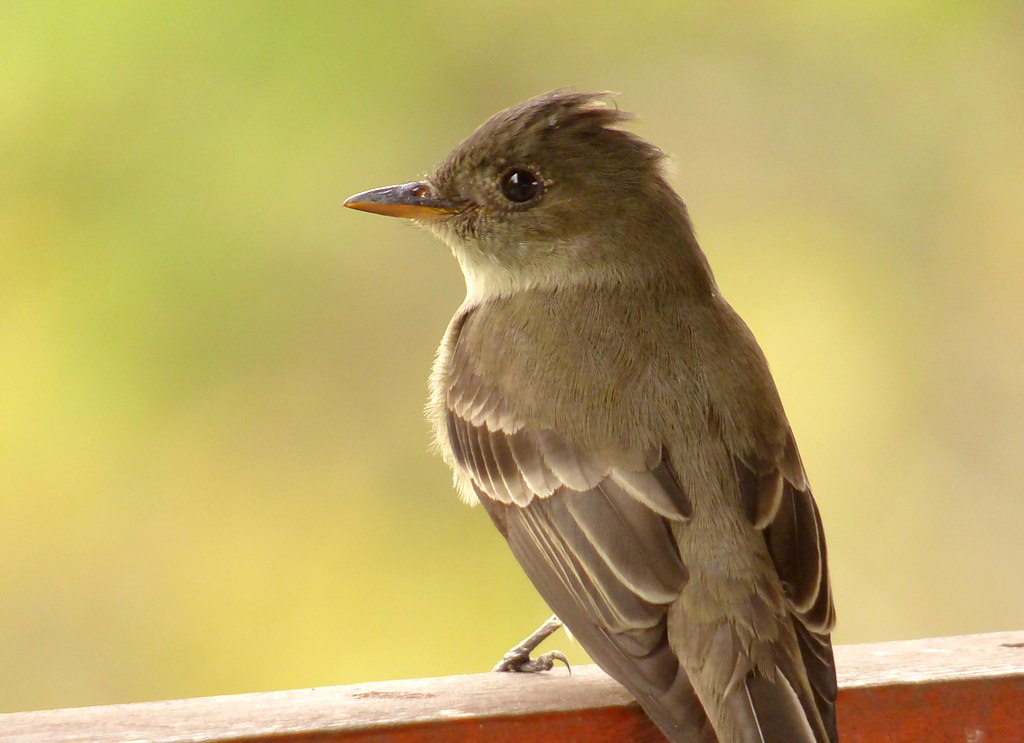
Coloration and Markings: Eastern Wood Peewees are olive-gray birds with their wings being a darker noticeably darker shade than the rest of their bodies. They also have a yellowish or whitish breast and underbelly, with the color darkening slightly towards the sides. Facially, these birds have long, sharp bills which are generally orange on the underside. The contrasting gray to the black makes their eyes appear a little large.
Size: These birds are approximately Sparrow sized, measuring around 5.9 inches in length and with a wingspan of 9.1 to 10.2 inches.
Habitat: These birds are going to be most commonly found in parks or woods, but if your backyard has a good number of trees and you hear a distinctive ‘pee-a-wee’ call then be on the lookout. They are distinctive enough to instantly track.
Diet: These birds like to eat flies, so while you can spot them if you have a woodlot or if you catch the occasional wandering Peewee during breeding season you will not be able to tempt them to your feeder.
Eastern Kingbird – Tyrannus tyrannus
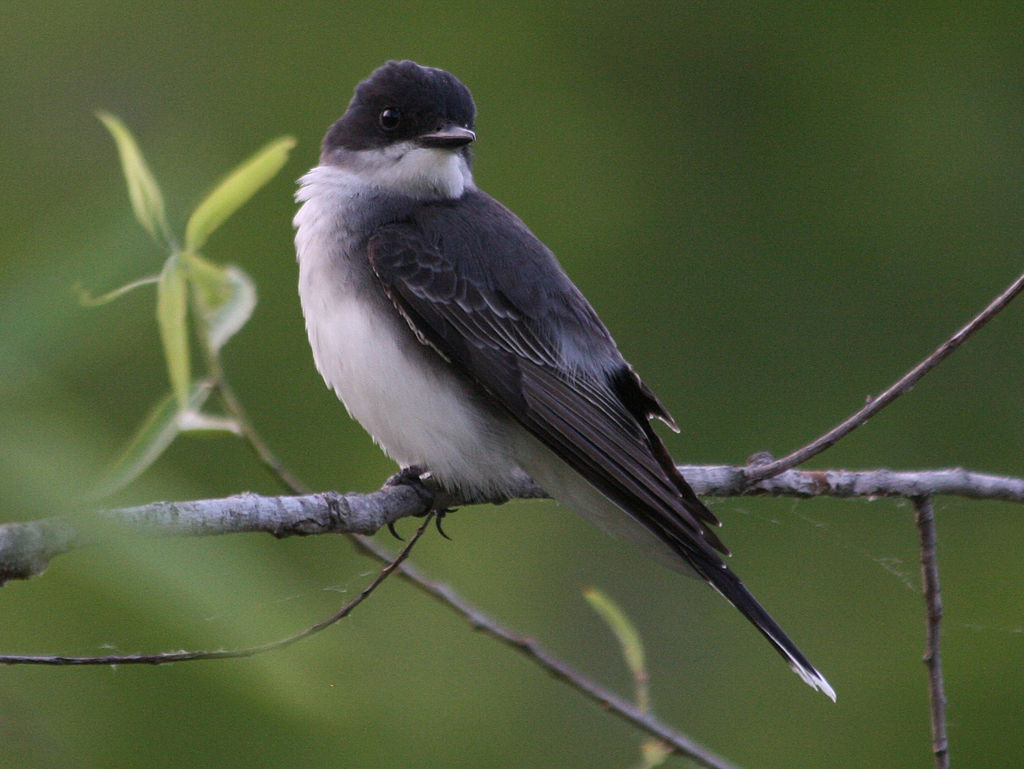
Coloration and Markings: The Eastern Kingbird looks snappy! This bird has gray-black wings and tail, with said tail tipped a smart-looking white. The breast and belly are completely white and the effect is nicely completed with the birds head. First, the white from the breast extends to the face and stops under its straight, sharp black bill. Secondly, the rest of its face is black and it is a darker black than its wings. It looks like a little bird bird in a suit!
Size: This bird measures in at 7.5 – 9.1 inches lengthwise with a wingspan of 13 to 15 inches.
Habitat: These birds Winter in South America so they like haunting a number of locations. You can find them in fields, forest edges, and even marshlands.
Diet: While this bird is a flycatcher like the Eastern Wood Peewee it does have some other favorite foods. Berry bushes in your yard can attract them, especially if you’ve got a lot of trees as well.
Brown Thrasher – Toxostoma rufum
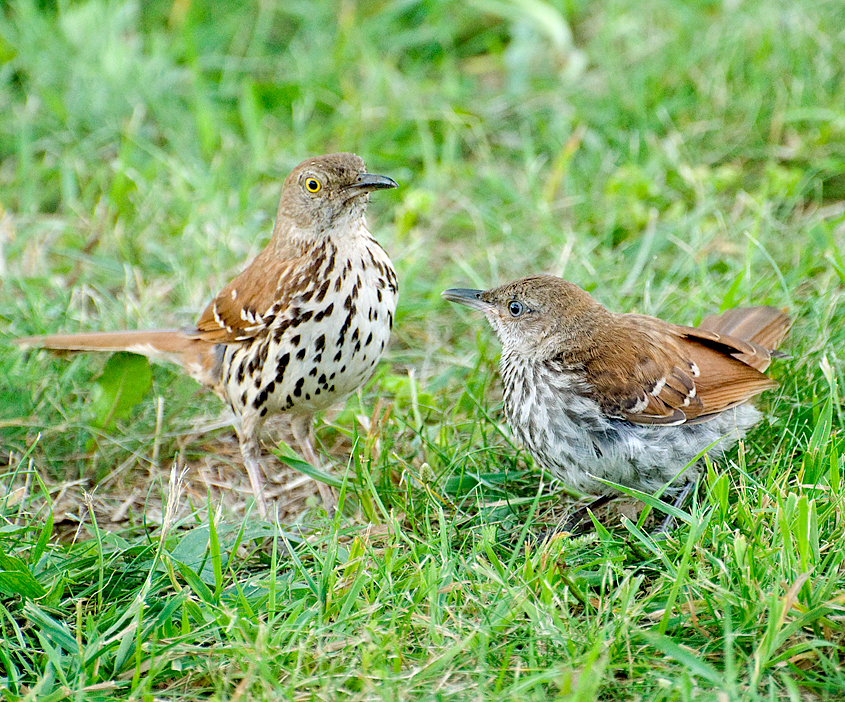
Coloration and Markings: Brown Thrashers have a rich brown color to their wings and back, with black and white wingbars to really set off the color. Their breast and lower belly areas are white with a bold brown streaking that will also make you wonder how they can hide so well in the first place. Facially, these birds are also brown but mixed in with gray. Combine this with their bright yellow eyes and their long, sharp black bills and you have on formidable-looking and handsome Songbird.
Size: These Songbirds measure in at a goodly-sized 9.1 – 11.8 inches with wingspans of 11.4 to 12.6 inches.
Habitat: While they like singing in the trees at the forest’s edge or simply in the woods, these birds are also fond of dense vegetation such as shrubberies where they may safely forage within its protective cover.
Diet: These birds can be lured out of protective cover for feeder snacks though they would prefer dense berry bushes in your yard. As far as feeder selections, they like suet, cracked corn, peanuts, and sunflower seeds.
Supporting cast (Other Backyard Birds of Indiana That Might Pay You a Visit)
To increase your odds of seeing some of the wonderful celebrity birds of our list, we’ve included a whole ‘supporting cast’ of extra ‘year round’ birds that you can watch for. Keep an eye out for these:
- Downy Woodpecker
- Tufted Titmouse
- European Starling
- Carolina Chickadee
- American Goldfinch
Downy Woodpecker – Picoides pubescens
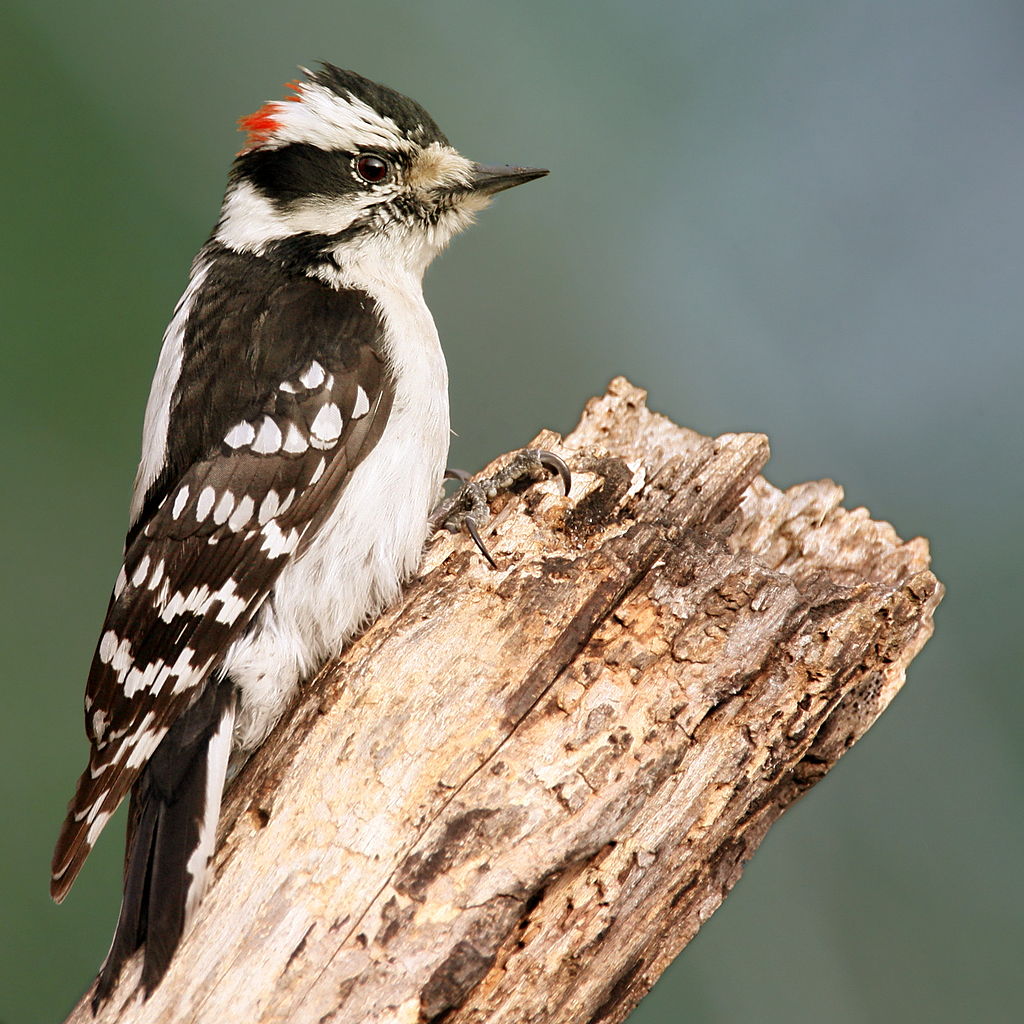
Coloration and Markings: Woodpeckers are favorites of a lot of birdwatchers and for good reason. They’re seldom shy and they look sharp. Take the Downy Woodpecker, for instance. These little guys have black wings with white spotting that gives them a distinctive checkered look that gets your attention. They have a wide white stripe across the back as well while their breast and underbelly are solid white. Facially, they look focused, with white faces that also have a mustache line going from the bill and a black mask which extends to the back of the neck. A black center stripe is on the top of the head and where it terminates the males have a beautiful red spot, where the females will display white. These birds have short, black bills and short black tails which are white on the underside. All in all, a good looking Woodpecker.
Size: Fairly small for a Woodpecker, the Downy measures in at 5.5 – 6.7 inches with a wingspan of 9.8 to 11.8 inches.
Habitat: While they love deciduous woods these birds are also no stranger to parks and backyards with a few trees to make them comfortable.
Diet: You can lure these little guys with peanuts (even peanut butter), suet, millet, and Black Oil Sunflower seeds.
Tufted Titmouse – Baeolophus bicolor
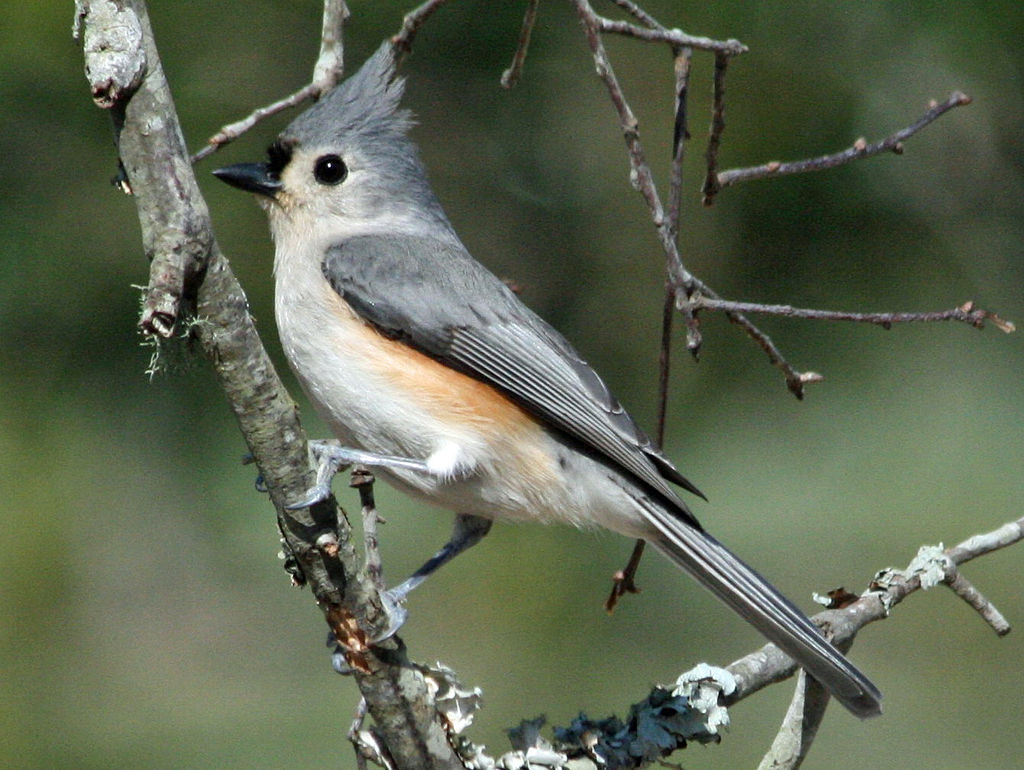
Coloration and Markings: The Tufted Titmouse is a lovely little bird that shows coloration doesn’t have to be complex to be beautiful. Their wings are a blue gray that is easy on the eyes and contrasts well with the breast and lower belly, which is white with some peach coloring splashed in at the belly area. Facially, they have a small blue crest and the blue extends to the back of the neck to frame the rest of the face which is white… with one exception. This bird has a distinctive black patch over its small, curved bill and big, black eyes. This is one you’ll love spotting.
Size: This birds measures in at 5.5 – 6.3 inches in length with a wingspan of 7.9 to 10.2 inches.
Habitat: These birds like Evergreen forests but they are also at home in the suburbs, eagerly visiting feeders and gardens in many a backyard.
Diet: These birds like Suet but Black Oil sunflower seeds are favorites which they will be more than happy to sup and snack on.
European Starling – Sturnus vulgaris
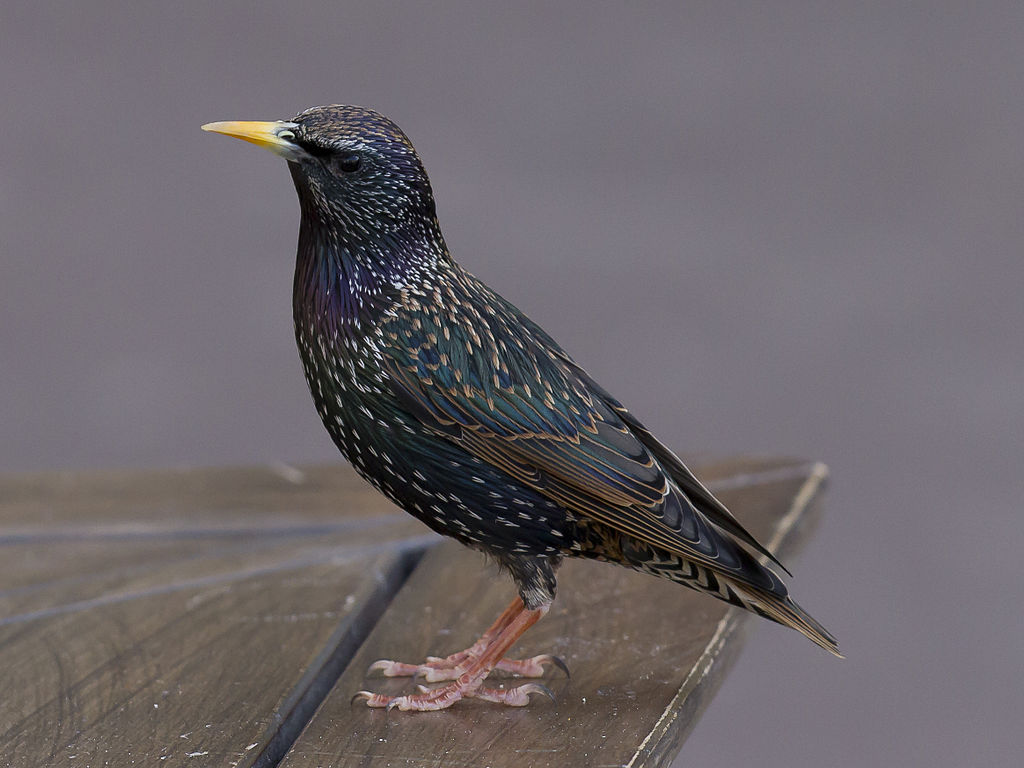
Coloration and Markings: This is another bird with simple but elegant coloration. At first you will think that it is simply black but closer scrutiny reveals that they are a mix of purple and green that shines with a pretty gloss. That is until winter, however, when these birds are brown with white spots. Facially, these birds have long, straight yellow bills but there is no color deviation in the face.
Size: The European Starling measures in at 7.9 – 9.1 inches and has a wingspan of 12.2 to 15.8 inches.
Habitat: These birds know that being close to humans has its advantages. You’ll see them just about anywhere in town, from telephones poles to sidewalks. They will be more than happy to visit your garden.
Diet: These birds will eat just about anything but their love for grain has caused a bit of consternation, as these birds are smart enough to steal it from granaries and this raises contamination worries. If you want to lure them in, however, standards such as suet, Sunflower seeds, and peanuts will work just fine and these smart birds ARE fun to watch.
Carolina Chickadee – Poecile carolinensis
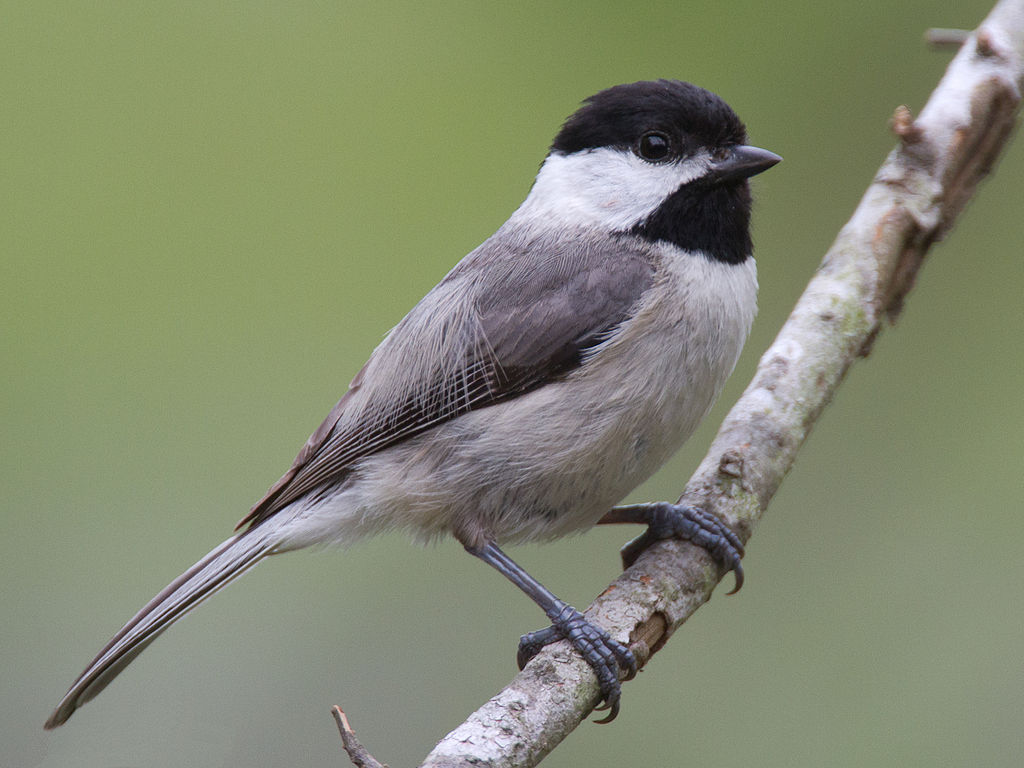
Coloration and Markings: The Carolina Chickadee is a pretty little bird. It’s wings are a light gray with the grey deepening down the wings and down to their tails. Their underbellies and breast are a pleasing snow white which carries up to the base of the throat. Facially, this bird has a large black cap which extends across the entire face at a level equal with the middle of its eye. Underneath this the bird is white until the point under its bill, where the black on its throat curves down to pleasing effect. Simple and beautiful.
Size: A tiny bird, the Carolina Chickadee measures in at 3.9 – 4.7 inches in length with a wingspan of 5.9 to 7.9 inches.
Habitat: These birds love forests, parks, and backyards equally.
Diet: Suet, crushed peanuts, and Black Oil sunflower seeds are a winning combination for tempting these little beauties.
American Goldfinch – Spinus tristis

Coloration and Markings: The American Goldfinch has a bright yellow back but black wings, with bright white markings going across and all the way down to the tail in a stunning contrast. Their breast and underbelly are the same yellow as their backs and their medium-sized tails are marked with wite patches both on top and below the tail. Facially, the bird has a bright yellow head up until the forehead, where it wears a jaunty black cap above a sharp, orange bill. Females are olive colored in the black spots and have a less vibrant yellow color. In winter these birds also reduce their colors to browns and black, though there are two faint wingbars to help you identify them.
Size: The American Goldfinch measures at 4.3 – 5.1 inches with a wingspan of 7.9 to 8.7 inches.
Habitat: These birds love backyards but they are also quite fond of fields and roadsides.
Diet: These birds can be lured in sunflower seeds but they really love Nyjer seeds and Thistle.
Indiana Bird Buffet
If you’d like to make your own ‘Indiana Bird Buffet’ then you are in luck. We’ve done a little research and found some favorites that are good to have in your feeders for those little angels. Try using the following:
- Black Oil Sunflower
- Peanuts
- Suet
- Nyjer
- Thistle
- Safflower
Indiana Birding Hot Spots
If you are visiting Indiana or would just like to know some other birdwatching areas which we would recommend then we’ve got a few places for you to consider. These are spread about on the map at various geographical points so there should hopefully be one that you like which is close. Consider a visit to one (or all) of the following:
- Northern hotspot – Winona Interurban Trail
- Eastern hotspot – Union City Gateway trail
- Southern hotspot – Columbus People Trail
- Western hotspot – Covington Circle Trail
- Central hotspot – Centennial Trail
Detailed descriptions of each location as well as information regarding visiting and what birds you can see at these locations may be found at https://www.traillink.com/trailsearch/?state=in&activities=BIRD
In Closing
Today we have briefly explored the birding scene in beautiful Indiana. We hope that you’ve seen some new birds to look for or maybe even just given you some ideas on luring that local bird you’ve already got your eyes on. We’ve included some reference information below just in case you’d like to have a look and until next time, we wish the happy birdwatchers from the Hoosier state the best!
